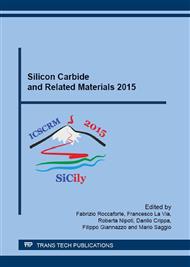p.53
p.57
p.61
p.65
p.69
p.73
p.77
p.81
p.85
Effects of Hydrogen Concentration on the Growth of High Purity 4H-SiC Single Crystal Grown by Sublimation Method
Abstract:
In this paper, the effects of hydrogen concentration on growth rate, micropipe density and nitrogen concentration of 4H-SiC crystals were discussed. It was shown that the growth rate is a linear function of the hydrogen concentration, which can be explained not only by C/Si ratio but also the temperature gradient. It was also found that the micropipe density was increased rapidly when the hydrogen concentration exceed a critical value, because the defects such as Si droplets, carbon inclusions and polytype formation were generated at that time. The results of secondary ion mass spectroscopy (SIMS) showed that with increasing the hydrogen concentration, the nitrogen concentration falls down but reaches a constant value which meets the requirements for high purity semi-insulating (HPSI) SiC single crystal growth. Finally, the HPSI 4H-SiC crystals were obtained using 15% hydrogen concentration, the resistivities of wafers cut from these crystals were more than 109Ω•cm, micropipe densities were less than 5cm-2, the full width at the half-maximum (FWHM) were between 30-40 arcsec, making these wafers suitable for microwave devices fabrication.
Info:
Periodical:
Pages:
69-72
Citation:
Online since:
May 2016
Authors:
Price:
Сopyright:
© 2016 Trans Tech Publications Ltd. All Rights Reserved
Share:
Citation:


